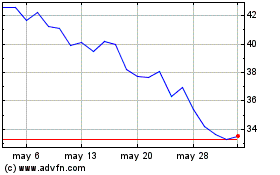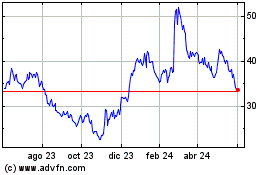Celldex Therapeutics Presents Data Demonstrating Profound Improvements in Angioedema in Barzolvolimab Phase 2 Study in Chronic Spontaneous Urticaria at EAACI 2024
02 Junio 2024 - 8:01AM

Celldex Therapeutics, Inc. (NASDAQ:CLDX) today announced data
demonstrating that barzolvolimab profoundly improves angioedema at
12 weeks in the Company’s Phase 2 clinical trial in chronic
spontaneous urticaria (CSU). Angioedema, characterized by swelling
of the deeper dermal layers of the skin and
mucous membranes, is a painful, debilitating symptom of CSU
that has significant impact on quality of life. It commonly affects
the face (lips and eyelids), hands, feet, and genitalia but
can also involve the tongue, uvula, soft palate,
and pharynx1.
The data were presented today by Dr. Marcus Maurer, Professor of
Dermatology and Allergy at Charité – Universitätsmedizin in Berlin,
in an oral presentation at the European Academy of Allergy and
Clinical Immunology (EAACI) Congress 2024. Celldex previously
announced that the Phase 2 study in CSU met its primary and
secondary endpoints at 12 weeks with clinically meaningful and
statistically significant decreases in UAS7 (weekly urticaria
activity score) compared to placebo across multiple dose groups and
demonstrated a favorable safety profile. The data presented today
further support these results by demonstrating improvements in AAS7
(weekly angioedema activity score) and additional measures of
angioedema control.
“The majority of patients with severe CSU suffer with
angioedema, which is often extremely painful and causes
disfigurement, dramatically impacting quality of life,” said Diane
C. Young, MD, Senior Vice President and Chief Medical Officer of
Celldex Therapeutics. "Consistent with previously reported clinical
outcomes, we observed rapid, durable and significant angioedema
relief, including in omalizumab refractory disease. These data
continue to support barzolvolimab’s potential to become a
transformative treatment option for CSU and we look forward to
moving closer to this goal with the initiation of our Phase 3
studies this summer.”
|
Phase 2 Barzolvolimab Study in CSU
(n=208)Summary of Angioedema Clinical Activity
Assessments at Week 12 |
|
|
300 mg Q8W(n=51) |
150 mg Q4W(n=52) |
75 mg Q4W(n=53) |
Placebo(n=51) |
|
Angioedema at baseline, n (%) |
42 (82%) |
35 (67%) |
40 (75%) |
32 (63%) |
|
AAS7 Changes |
|
Baseline AAS7 (mean) |
53.15 |
54.60 |
54.05 |
56.30 |
|
LS Mean difference from placebo (Confidence Interval, p value) |
-25.32 (CI:-36.32, -14.32)p<0.0001 |
-23.56(CI:-35.08, -12.04)p<0.0001 |
-17.52(CI:-29.35, -5.69)p=0.0039 |
|
|
>8 point improvement in AAS7 (%) |
85.0P<0.05 |
87.1P<0.05 |
82.9P<0.05 |
57.1 |
|
Angioedema Free Days (mean) |
65.1P<0.05 |
54.5P<0.05 |
43.3 |
36.2 |
| AAS7 data were analyzed using ANCOVA model and
multiple imputation. Data are presented for patients with
angioedema at baseline. |
| |
- Barzolvolimab demonstrated significant improvements in AAS7 in
patients with angioedema across all doses at Week 12. This
improvement was rapid (within 2 weeks) and durable (continued
through 12 weeks).
- Barzolvolimab demonstrated strong improvement in AAS7
independent of omalizumab status at Week 12. Approximately 20%
(n=41) of enrolled patients received prior treatment with
omalizumab and more than half of these patients had
omalizumab-refractory disease. These patients experienced a similar
clinical benefit as the overall treated population within their
individual dosing groups consistent with the barzolvolimab
mechanism of action.
- Patients on barzolvolimab experienced a > 8 point
improvement in AAS7 (considered a clinically meaningful result)
across all doses compared to placebo (p<0.05).
- Barzolvolimab increased angioedema free days compared to
placebo through 12 weeks. Patients in the 300 mg cohort were
angioedema free 77% of the time over the 12 week period.
Phase 2 Study Design The randomized,
double-blind, placebo-controlled, parallel group Phase 2 study is
evaluating the efficacy and safety profile of multiple dose
regimens of barzolvolimab in patients with CSU who remain
symptomatic despite antihistamine therapy, to determine the optimal
dosing strategy. 208 patients were randomly assigned on a 1:1:1:1
ratio to receive subcutaneous injections of barzolvolimab at 75 mg
every 4 weeks, 150 mg every 4 weeks, 300 mg every 8 weeks or
placebo during a 16-week placebo-controlled treatment period. After
16 weeks, patients then enter a 36-week active treatment period, in
which patients receiving placebo or the 75 mg dose are randomized
to receive barzolvolimab 150 mg every 4 weeks or 300 mg every 8
weeks; patients already randomized to the 150 mg and 300 mg
treatment arms remain on the same regimen as during the
placebo-controlled treatment period. After 52 weeks, patients then
enter a follow-up period for an additional 24 weeks. The primary
endpoint of the study is mean change in baseline to Week 12 in UAS7
(weekly activity score). Secondary endpoints include other
assessments of safety and clinical activity including ISS7 (weekly
itch severity score), HSS7 (weekly hives severity score) and AAS7
(weekly angioedema activity score).
For additional information on this trial (NCT05368285), please
visit www.clinicaltrials.gov
1DermNet.
About Chronic Spontaneous Urticaria (CSU)CSU is
characterized by the occurrence of hives or wheals for 6 weeks or
longer without identifiable specific triggers or causes. The
activation of the mast cells in the skin (release of histamines,
leukotrienes, chemokines) results in episodes of itchy hives,
swelling and inflammation of the skin that can go on for years or
even decades. Current therapies provide symptomatic relief only in
some patients.
About BarzolvolimabBarzolvolimab is a humanized
monoclonal antibody that binds the receptor tyrosine kinase KIT
with high specificity and potently inhibits its activity. KIT is
expressed in a variety of cells, including mast cells, which
mediate inflammatory responses such as hypersensitivity and
allergic reactions. KIT signaling controls the differentiation,
tissue recruitment, survival and activity of mast cells. In certain
inflammatory diseases, such as chronic urticaria, mast cell
activation plays a central role in the onset and progression of the
disease. Barzolvolimab is currently being studied in chronic
spontaneous urticaria (CSU), chronic inducible urticaria (CIndU),
prurigo nodularis (PN) and eosinophilic esophagitis (EOE) with
additional indications planned for the future, including atopic
dermatitis (AD).
About Celldex Therapeutics, Inc.Celldex is a
clinical stage biotechnology company leading the science at the
intersection of mast cell biology and the development of
transformative therapeutics for patients. Our pipeline includes
antibody-based therapeutics which have the ability to engage the
human immune system and/or directly affect critical pathways to
improve the lives of patients with severe inflammatory, allergic,
autoimmune and other devastating diseases. Visit
www.celldex.com.
Forward Looking Statement This release contains
"forward-looking statements" made pursuant to the safe harbor
provisions of the Private Securities Litigation Reform Act of 1995.
These statements are typically preceded by words such as
"believes," "expects," "anticipates," "intends," "will," "may,"
"should," or similar expressions. These forward-looking statements
reflect management's current knowledge, assumptions, judgment and
expectations regarding future performance or events. Although
management believes that the expectations reflected in such
statements are reasonable, they give no assurance that such
expectations will prove to be correct or that those goals will be
achieved, and you should be aware that actual results could differ
materially from those contained in the forward-looking statements.
Forward-looking statements are subject to a number of risks and
uncertainties, including, but not limited to, our ability to
successfully complete research and further development and
commercialization of Company drug candidates, including
barzolvolimab (also referred to as CDX-0159), in current or future
indications; the uncertainties inherent in clinical testing and
accruing patients for clinical trials; our limited experience in
bringing programs through Phase 3 clinical trials; our ability to
manage and successfully complete multiple clinical trials and the
research and development efforts for our multiple products at
varying stages of development; the availability, cost, delivery and
quality of clinical materials produced by our own manufacturing
facility or supplied by contract manufacturers, who may be our sole
source of supply; the timing, cost and uncertainty of obtaining
regulatory approvals; the failure of the market for the Company's
programs to continue to develop; our ability to protect the
Company's intellectual property; the loss of any executive officers
or key personnel or consultants; competition; changes in the
regulatory landscape or the imposition of regulations that affect
the Company's products; our ability to continue to obtain capital
to meet our long-term liquidity needs on acceptable terms, or at
all, including the additional capital which will be necessary to
complete the clinical trials that we have initiated or plan to
initiate; and other factors listed under "Risk Factors" in our
annual report on Form 10-K and quarterly reports on Form 10-Q.
All forward-looking statements are expressly qualified in their
entirety by this cautionary notice. You are cautioned not to place
undue reliance on any forward-looking statements, which speak only
as of the date of this release. We have no obligation, and
expressly disclaim any obligation, to update, revise or correct any
of the forward-looking statements, whether as a result of new
information, future events or otherwise.
Company ContactSarah CavanaughSenior Vice
President, Corporate Affairs & Administration(508)
864-8337scavanaugh@celldex.com
Patrick TillMeru Advisors(484)
788-8560ptill@meruadvisors.com
Celldex Therapeutics (NASDAQ:CLDX)
Gráfica de Acción Histórica
De May 2024 a Jun 2024

Celldex Therapeutics (NASDAQ:CLDX)
Gráfica de Acción Histórica
De Jun 2023 a Jun 2024
